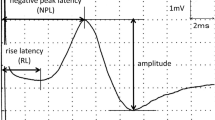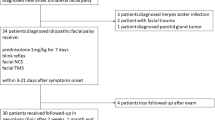Abstract
The purpose of this study was to evaluate the ability of electroneuronography (ENOG), also called evoked electromyography (EEMG), and facial nerve latency testing (FNLT) to assess the prognosis of facial nerve palsy, using the House-Brackmann facial nerve grading system as criterion. From 1988 to 1994 these tests were employed at the ORL Clinic of the University of Ioannina in 250 patients with idiopathic facial nerve palsy. The ENOG test results indicated that when the amplitude of the compound muscle action potentials ranged from 51% to 95% of the normal value, 97% of the patients achieved complete functional recovery (grade 1) within at least 2 months. When the muscle action potential decreased to a value below 51% of normal values, prognosis for recovery was considerably worse. FNLT test results indicated that as the latency time extended, the recovery grade of the facial nerve worsened. When latency time was within the normal range (group A patients), about 92% of patients had complete functional recovery. In contrast all patients having either a very extended latency time or unable to be monitored (groups C and D) demonstrated incomplete functional recoveries that ranged from grade 11 to grade VI. Comparing each test with the House-Brackmann facial nerve grading system, we ascertained that the percent accuracy for ENOG was 97.6%, and that for FNLT was 94.4%.
Similar content being viewed by others
References
Adour K K, Kedar K, Muray I (1980) Maximal nerve excitability testing versus neuromyography: prognostic value in patients with facial paralysis. Laryngoscope 90:1540–1547
Campbell E D R, Hickey RD, Nixon KH (1962) Value of nerve-excitability measurements in Prognosis of facial palsy. BMJ 2:7–10
Danielides V, Skevas A, Kastanioudakis I, Anastasopoulos D (1993) Vergleich der prognostischen Aussagefähigkeit zwischen Nerve Excitability Test (NET) and Maximum Stimulation Test bei der Beurteilung der Bellschen Lähmung. HNO 41:417–420
Devriese PP, Schumacher T, Scheide A, De Jongh RH, Houtkooper JM (1990) Incidence, prognosis and recovery of Bell's palsy. A survey of about 1000 patients (1974–1983). Clin Otolaryngol Allied Sci 15:15–27
Esslen E (1973) Electrodiagnosis of facial palsy. In Miehlke A (ed) Surgery of the facial nerve. Urban and Schwarzenberg, Munich, pp 49–51
Fish U (1977) Total facial nerve decompression and electroneurography. In Silverstein H, Norrell H (eds) Neurological surgery of the ear. Aesculapius, Birmingham, Ala, pp 21–33
Fish U (1981) Surgery for Bell's palsy. Arch Otolaryngol Head Neck Surg 107:1–11
Gilliat RW, Taylor JC (1959) Electrical changes following section of the facial nerve. Proc R Soc Med 52:1080–1083
House JW, Brackmann DE (1985) Facial nerve grading systems. Otolaryngol Head Neck Surg 93:146–147
Joachims HZ, Bialik V, Eliachar I (1980) Early diagnosis in Bell's palsy. Laryngoscope 90:1705–1708
Langworth EP, Taverner D (1963) The prognosis in facial palsy. Brain 86:465–480
Laumans EPJ (1965) Nerve excitability tests in facial paralysis. Arch Otolaryngol 81:478–488
May M, Harvey JE, Marovitz WF (1971) The prognostic accuracy of maximum stimulation test compared with that of the nerve excitability test in Bell's palsy. Laryngoscope 81:931–938
May M, Blumenthal F, Klein SR (1983) Acute Bell's palsy: prognostic value of evoked electromyography maximal stimulation and other electrical tests. Am J Otol 5:1–7
Rogers RL (1978) Nerve conduction time in Bell's palsy. Laryngoscope 88:314–316
Skevas A, Danielides V, Assimakopoulos D (1990) The role of the facial nerve latency test in the prognosis of Bell's palsy. Laryngoscope 100:1083–1085
Sunderland S(1978) Nerve and nerve injuries, 2nd edn. ChurchillLivingstone, London, pp 88–89, 96–97, 133
Taverner D (1965). Electrodiagnosis in facial palsy. Arch Otolaryngol 81:470–477
Author information
Authors and Affiliations
Rights and permissions
About this article
Cite this article
Danielides, V., Skevas, A. & Van Cauwenberge, P. A comparison of electroneuronography with facial nerve latency testing for prognostic accuracy in patients with Bell's palsy. Eur Arch Otorhinolaryngol 253, 35–38 (1996). https://doi.org/10.1007/BF00176700
Received:
Accepted:
Issue Date:
DOI: https://doi.org/10.1007/BF00176700




